2020 Rocky Mountain Instinct BC Edition
Test Locations: Crested Butte & Gunnison, Colorado
Duration of Test: ~1 month
Size Tested: Large
Geometry: See Below
Build Overview (Carbon 70 BC Edition):
- Drivetrain: Shimano XT 12-speed
- Brakes: Shimano XT 4-piston, 203 mm rotors
- Fork: Fox Float 36 GRIP2 Performance Elite, 160 mm
- Rear Shock: Fox Float DPX2 Performance
- Wheelset: Race Face AR Offset 30 rims; Rocky Mountain Sealed hub (front) & DT Swiss 370 hub (rear)
Wheel Size: 29′′
Suspension Travel: 155 mm rear / 160 mm front
Blister’s Measured Weight (as built, tubeless, w/o pedals): 30.0 lbs
MSRP (as built): $5,999 USD
Reviewers:
- Dylan Wood: 5’11”, 155 lbs / 180 cm, 70 kg; Ape Index +0.5; Inseam 32” / 81 cm
- Eric Freson: 5’10”; 165 lbs / 178 cm, 75 kg; Ape Index +1.5; Inseam 31″ / 79 cm
- Luke Koppa: 5’8”, 155 lbs / 173 cm, 70 kg; Ape Index +1; Inseam 31” / 79 cm
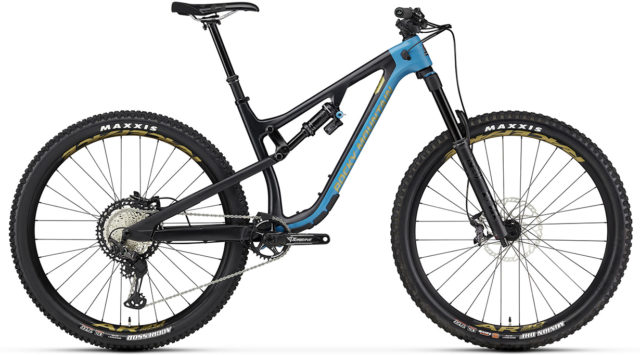
Intro
Since 2013, Rocky Mountain’s Instinct has served as the brand’s do-everything, full-suspension, 29er Trail bike. Rocky Mountain updated the Instinct in 2017, and they also added a longer-travel, more downhill-oriented version that we’re reviewing here, the Instinct BC Edition.
With 155 mm of rear travel and a 160mm-travel fork, the Instinct BC is situated in the popular, diverse, and convoluted category of “aggressive Trail” / Enduro 29ers. I got a few rides on the Instinct BC in the Gunnison-Crested Butte valley and now fellow reviewers Eric Freson and Luke Koppa have added their thoughts. First, we’ll dive into the specs, build options, etc., then we’ll each provide our take on the bike’s on-trail performance.
The Frame
The Instinct BC Edition is available in either an alloy or carbon frame. Apart from the obvious differences in material, the lower-end build kits are paired with the alloy frame while the higher-end kits are paired with the carbon frame, with the exception being the “70” build, which is available (with some component differences that we touch on below) on both frames.
[Note: Rocky Mountain recently announced a voluntary recall for certain alloy Instinct and alloy Pipeline front triangles made from 2018–2020. If you have one, click here to figure out if you need to get a free replacement front triangle. This recall does not include any of the carbon Instinct frames.]
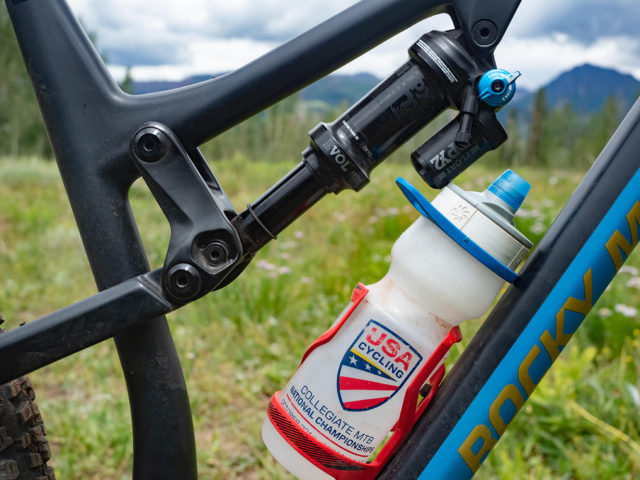
The Instinct BC Edition features Rocky Mountain’s “Smoothlink” suspension that is ultimately a 4-bar, Horst Link design. I’ve been able to fit a 20-oz water bottle in the front triangle of the Instinct BC, but as you can see in the image above, it’s a very tight fit with the piggyback of the DPX2 shock.
While the normal Instinct — with 140 mm of rear travel — features Rocky Mountain’s Ride-9 geometry / suspension adjustment system, the BC Edition does not, since the frame does not have enough clearance for 155 mm of rear travel in 8 of the Instinct’s 9 different positions. So while many of Rocky Mountain’s frames offer a ton of different ways to adjust the geometry, the Instinct BC takes the guesswork (and customization options) out of the equation.
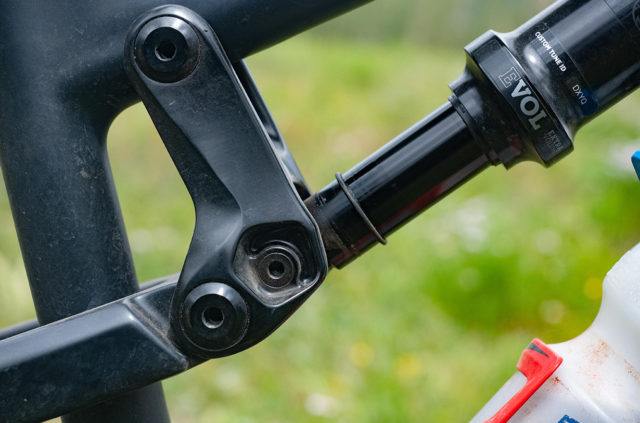
The Instinct frames come with Rocky Mountain’s “spirit guide” — an upper chain guide that cleverly secures to the frame with clean integration. The frames also feature full-sealed cartridge bearings; a press-fit bottom bracket; two (not three, due to the integrated upper guide) ISCG 05 tabs; some protection under the downtube, bottom bracket and on top of the chainstay; and internal cable routing through the front triangle.
It is also worth noting that the Instinct can be converted to the Instinct BC Edition, and vice-versa. Conversion requires a different rear link, a rear shock that is longer / shorter in stroke length and eye-to-eye length, and a longer / shorter fork, depending on which way the bike is converted. The normal Instinct uses a 210 mm x 55 mm rear shock while the BC Edition runs a 8.5” x 2.5” shock, which is indeed longer.
Rocky Mountain says the Instinct BC Edition can run a rear tire up to a 2.5” wide with 29” wheels (which is shown below with the stock 2.5” Maxxis Aggressor), and the Instinct frame is also compatible with a 27.5”+ setup, allowing tires up to 3” wide with the smaller wheels.
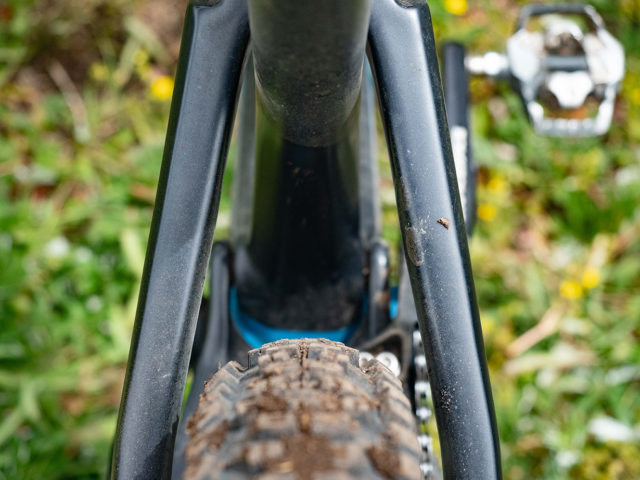
The Builds
Rocky Mountain currently offers the Instinct BC as a carbon frame with a Fox Factory DPX2 shock for $2,899, or in four complete builds ranging from the $3,899, SRAM GX-equipped Alloy 50 to the $7,199, SRAM X01-equipped Carbon 90. In between sit the $4,699 Alloy 70 and the build we’ve been riding, the $5,999 Carbon 70, both of which feature Shimano’s XT drivetrain and XT 4-piston brakes.
All full Instinct BC builds come with a Maxxis Minion DHF EXO up front and a Maxxis Aggressor EXO out back, with the Aggressor being noteworthy in that it’s on the faster-rolling / less aggressive end of the spectrum for a longer-travel bike like the Instinct BC.
All builds apart from the high-end Carbon 90 come with Raceface AR 30 rims laced to DT Swiss 370 Boost hub in the rear and a Rocky Mountain hub up front. Bumping up to the Carbon 90 gets you Raceface’s carbon ARC 30 rims and DT Swiss’s 350 Boost rear hub.
For droppers, all full builds come with a Raceface Turbine R (aka, a Fox Transfer), apart from the Alloy 70, which comes with a OneUp dropper. Rocky Mountain notes that the relatively straight seat tube of the Instinct BC allows for relatively deep dropper post insertion, and you can find more info on that for each size in the FAQ section of their product page.
The Carbon 70 build that we’re reviewing is equipped with a Shimano 12-speed XT drivetrain and XT 4-piston brakes. Fox handles suspension duties, with a 36 Performance Elite with a Grip2 damper up front and a DPX2 Performance out back. Raceface’s Turbine series makes up the bars (780 mm), cranks, and 32-tooth chainring, while some Rocky Mountain parts round out the stem and grips.
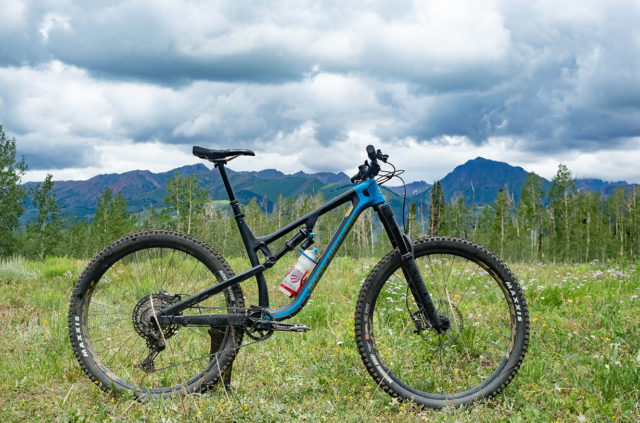
It’s also worth noting that you can get the same drivetrain and brakes with Fox Factory-level suspension for $1,300 less if you go to the Alloy 70 build.
Initial Thoughts on The Build
Dylan Wood: The Carbon 70 build kit provides a high-performance ride at an admirable weight (30 lbs on the dot for a size Large without pedals) and a fair price for what you get.
I’m a big fan of Shimano XT brakes and drivetrains, and the ones kitted on the Instinct BC Edition Carbon 70 have not disappointed. Particularly, I really like how well the XT drivetrain shifts under load, compared to most of SRAM’s offerings. The Raceface AR offset 30 rims laced to Rocky Mountain and DT Swiss hubs have a stiff, yet compliant feeling to them, and have stayed taught and true (as I’d expect, given the short ride time so far).
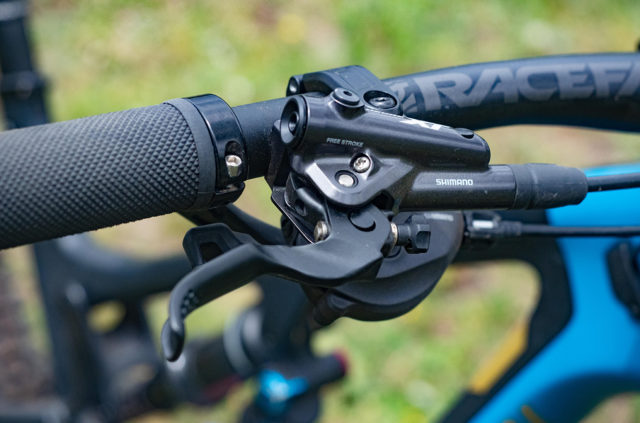
The Fox Float 36 Performance Elite fork with Grip2 damper provides just about as much adjustability in a fork that anyone could ask for, and only lacks Fox’s signature gold Kashima coating when compared to the “Factory” model.
The only weak point of this build, at least for me, is the Fox Float Performance DPX2 rear shock. This shock only gives you the ability to adjust rebound and set the compression damping in 3 pre-determined settings. I wish that Rocky Mountain had stocked the Performance Elite version here, which features low-speed compression damping in the “open” mode of the shock. Of course, if you rarely find yourself feeling the need to fine-tune your rear suspension, this will be a non-issue.
Also, I think riders who do lots of Enduro races and / or bike-park riding on the Instinct BC edition may want to upgrade to a more downhill-oriented shock like the Fox Float X2. On other bikes I have ridden with a Fox DPX2, I found that the shock had some issues “fading” and losing performance over longer descents. While burlier rear shocks may add a weight penalty, I believe the upgrade would be worth it if you want to frequently ride the Instinct BC Edition in lift-served bike parks or tend to ride long, rough descents.
Eric Freson: Chiming in here just to say I agree with all of Dylan’s points from above. But most specifically I did find that the DPX2 would lose some rebound damping performance on longer (10–15 min) descents.
Luke Koppa: Yeah, Dylan hit pretty much all of the highlights.
I love the XT drivetrain and will be putting that or the new Deore 12-speed on my next personal bike — so smooth and reliable under power. I still prefer the modulation of SRAM Codes to the XT brakes, but I’ve been able to adjust pretty quickly and they’ve provided plenty of stopping power for me.
Coming from a Fox Rhythm 36 with very minimal adjustment options, I’ve been kind of amazed by how much I prefer the Performance Elite version on the Instinct BC Carbon 70. If you’re a relatively new mountain biker like me and think things like high- and low-speed compression adjustments are just for racers, I’d definitely recommend at least playing around with a higher-end fork if possible.
I’ve been pretty content with lower-end DPX2 shocks on a few different bikes and haven’t ridden the Float X2 so I can’t really comment there. As I touch on below, I’d like to try the Instinct BC’s DPX2 with another volume spacer since I feel like I’ve bottomed it out a few times where I wouldn’t expect that to happen, but haven’t yet been able to experiment with that. As for it “fading” on longer descents, that’s not something I’ve really noticed but I’m also less sensitive to that than Dylan and Eric are.
This was my first time using a Race Face Turbine R dropper (aka, a Fox Transfer), and I’m a big fan. Super smooth, fast but not fear-for-my-manhood fast, and with a nice, reassuring “clunk” at full extension. During the first few rides, I felt like I would’ve preferred being able to get it slightly lower on descents (due to the bike’s frame, not the dropper itself), but I no longer noticed that after a few rides.
All in all, the Carbon 70 seems like it offers a great performance-to-price ratio and there’s nothing on it that I would want to immediately replace. And FWIW, if I were to buy this bike, I’d probably opt to save $1,300 with the Alloy 70 while getting higher-end suspension and happily dealing with the extra ~pound of the alloy frame.
Geometry
This is one area where the Instinct BC stands out from most of its long-ish-travel counterparts. Particularly given the releases of several new ~150mm-travel bikes this year, the Instinct BC’s geometry numbers look notably shorter and steeper.
For a size Large, the Instinct BC’s reach comes in at 454 mm, rear center is 435 mm, and the wheelbase comes out to 1213 mm. To put those into perspective, with all measurements for a size Large, Commencal’s newest 140mm-travel Meta TR has a 490 mm reach and 1257 mm wheelbase; Transition’s new Sentinel has a 476 mm reach and 1263 mm wheelbase; Norco’s recently revised Sight has a 485 mm reach and 1262 mm wheelbase; the Banshee Titan’s reach and wheelbase come in at 470 mm and 1265 mm, respectively; and Yeti’s not-super-new SB150 has a 480.2 mm reach and 1248 mm wheelbase.
So, compared to many of the recently released bikes in its class, the Instinct BC is notably shorter. It also has a steeper head angle than many, though, at 65.9°, it’s not extremely steep. The Instinct BC’s effective seat tube angle is fairly slack at 74.4°, though with its shorter reach, we thought this might not be as much of an issue on the climbs vs. if you had the same angle on a very long bike.
Given the Instinct BC’s “aggressive trail” design intentions, its geo is looking more conservative at this point, though we were curious to see how different that made it feel compared to some of the longer, slacker bikes in this class. Particularly, for people who think bikes in this class have been getting too long and slack for their riding style, should the Instinct BC be on their list?
For reference, here’s the whole geo chart for the Instinct BC:
Initial Thoughts on Fit and Geometry
Dylan Wood (5’11”, 155 lbs / 180 cm, 70 kg; Ape Index +0.5; Inseam 32” / 81 cm): As we just mentioned, the Instinct BC Edition does not feature radically progressive geometry, especially when compared to the most recent of long-travel 29ers. When I first swung a leg over the bike, the fit felt familiar to what I had become accustomed to on other long-travel 29ers of 2-3 years ago, like the Santa Cruz Hightower LT. With the Instinct BC’s 74.4º seat tube angle, the pedals are slightly more forward than I would like. I’ve gotten along better with bikes with a ~76-77º seat tube angle like the Santa Cruz Megatower and current Hightower, where the pedals are in a better spot to put down the power, especially when the terrain gets steep.
All that being said, in terms of overall fit, I think the Instinct BC Edition’s geometry creates something that could be comfortable and work for many people, provided you’re not someone who wants a very long and slack bike.
By sliding the seat forward on the rails, I can alleviate the slightly-too-slack seat tube angle, which to me, is the biggest downfall of the Instinct BC Edition’s geometry. Because top tube lengths have stayed relatively consistent while other aspects of geometry have changed within the last few years, the Instinct BC hasn’t felt too short or too stretched out while in a seated pedaling position compared to other long-travel 29ers I’ve been riding. While standing and pedaling or standing while descending, the shorter reach and wheelbase do become more apparent to me, since I’ve been spending most of my time this year on relatively new bikes that are longer in those regards (below I’ll get more into what that feeling translates to).
Eric Freson (5’10”; 165 lbs / 178 cm, 75 kg; Ape Index +1.5; Inseam 31″ / 79 cm): Overall, the Instinct BC’s fit and geo worked well for me. In an effort to dial in the fit to be similar to other bikes I have been spending time on (e.g., size Medium Pivot Firebird 29), I did find myself rolling the bars forward and moving my seat forward in the rails. The top tube of the Instinct BC did initially feel short to me when pedaling around the parking lot, but it wasn’t something I found myself thinking about when out on the trail.
Having spent time on several current bikes in this travel class, I honestly think I prefer bikes in the ~450–460 mm reach range, so I felt right at home on the size Large Instinct BC. And while its 1213 mm wheelbase might be a touch on the shorter side of optimal for me on our straight and fast trails, it didn’t keep me from going very fast aboard the bike.
As Dylan has said, the Instinct BC’s geo makes it a great choice for those who aren’t looking to hold the crown of “longest/slackest”, and maybe it’s just because Rocky Mountain is based in BC, but the bike’s somewhat shorter overall length makes me think of the old freeride bikes you’d see people riding around the North Shore back in the day.
Luke Koppa (5’8”, 155 lbs / 173 cm, 70 kg; Ape Index +1; Inseam 31” / 79 cm): I’m a smaller dude than Dylan and Eric (though I do have fairly long legs relative to my actual height), and I’ve felt very comfortable on most bikes in a size Medium. So it was initially surprising how immediately comfortable I felt on the size Large Instinct BC, but that’s also not that unusual when you look at the numbers. My personal bike is a size Medium, 2019 Specialized Enduro 27.5, which has reach and wheelbase numbers that sit right between the Medium and Large Instinct BC and a head angle that’s almost a degree slacker.
While I feel slightly more stretched out on the Large Instinct BC than I do on the Medium Enduro 27.5, it’s never really felt like I was too stretched out. It just feels nice, and I don’t think I’d prefer a size Medium Instinct BC. FWIW, at 5’8” / 173 cm, Rocky Mountain’s size chart puts me on the upper end of the range for a size Medium and the very bottom end for a size Large.
I haven’t had any major complaints regarding the Instinct BC’s fairly slack (by today’s standards) seat tube angle. I find myself inching forward on the saddle on the steepest of climbs and I kept the seat pushed forward after getting the bike from Eric, but I never felt like I had any truly noteworthy issues when it came to getting power to the pedals on climbs.
While descending, once again, the bike has just felt comfortable and intuitive to me. I found myself staying slightly more centered between the wheels than I do on the size Medium Enduro 27.5, where I feel best with a bit more weight over the front. But there was basically no adjustment period required for me to start riding as fast as I normally do (which, to put it insultingly lightly, is not quite as fast as Jesse Malamed, ALM, and Remi Gauvin have ridden this bike…). The size Large Instinct BC hasn’t felt any more cumbersome in tight corners vs. my Medium Enduro 27.5, but I’ve also very rarely felt like I was wishing that I was on something much longer and/or slacker (more on that later).
So with all that said, I think my main point here is that if you’re on the fence about sizing and have been riding and liking bikes from the past few years with somewhat long, modern geometry, the Instinct BC seems like a bike where the safer choice would likely be to go with the larger size of the two.
Climbing
Dylan Wood: While you shouldn’t expect a 155 mm Trail / Enduro bike to climb exceptionally well, I believe that the Instinct BC Edition can satisfy anyone interested in this sort of bike in terms of its climbing ability.
The Instinct BC’s anti-squat numbers are on the lower end of the spectrum at ~83% in the easiest climbing gear, while, for example, the Santa Cruz Megatower features ~100% anti-squat, depending on the geo setting you choose. Given this, it came as little surprise to me that the Instinct BC offered a notably more active suspension platform on the way up. This results in plenty of traction in bumpy and loose sections but a little bit more pedal bob on smooth fire roads compared to the Megatower and the old Hightower LT. As I touched on above, the Fox DPX2 on the Instinct BC Carbon 70 comes with a 3-position climb switch that does a good job of firming things up when desired. Like most other bikes I ride, I only touch this switch when I am pedaling up very smooth roads and trails.
If you spend most of your time pedaling up singletrack, the Instinct’s rear suspension offers a lot to like in terms of the amount of traction it provides. Combined with the fast-rolling Maxxis Aggressor rear tire, the Instinct BC Edition’s climbing performance is totally adequate for its class.
With a 32-tooth front chainring, the Instinct BC Edition has plenty of upper-end pedaling ability for me while sacrificing some easier pedaling in the lowest gears. Personally, I prefer a 30-tooth chainring paired with the 10-51 Shimano XT drivetrain, mostly because many of the climbs around Crested Butte are very steep and I prefer to pedal at a relatively high cadence.
Eric Freson: In contrast to Dylan, and as with just about every Horst-Link bike I have spent time on, I found the climb switch to be very necessary to achieve efficient-feeling climbing while aboard the Instinct BC. I’d agree with Dylan that there is a ton of traction on tap if you choose to leave the shock in its open position, but personally, I find that creates to much of a compromise in terms of feeling efficient when trying to convert watts into forward motion on anything other than the steepest and loosest of climbs. The shock is thankfully in an easy to reach location on the frame and the lever is easy to find, making it no big deal to use.
I also found the Instinct BC’s climbing performance to be adequate, and with the climb switch engaged, more than adequate for a bike of this type and intent (i.e., longer travel, “aggressive trail” category). I’m a fan of the Maxxis Aggressor as a rear tire — I often put it on my personal bikes, so it felt at home on the Instinct BC. The more average (or arguably below-average, at this point) reach number on the Instinct BC was welcome on the often steep and punchy climbs in Crested Butte, where getting over the nose of my saddle and relying on my quads can make the difference between making a climb, or not.
Again, personal choice, but with the 51-tooth cassette on the Instinct BC Carbon 70’s 12-speed XT drivetrain, I found myself going in the other direction and wishing the chainring was a 34 tooth. But other than that, climbing and shifting with Shimano’s 12-speed XT drivetrain makes me happy.
Luke Koppa: It’s really interesting to hear Dylan and Eric’s thoughts on the Instinct BC’s climbing performance, since my take has been a bit different. While Dylan and Eric were pretty much “fine” with how the Instinct BC climbed, I’ve absolutely loved going uphill on it. I think a lot of this probably comes down to the bikes each of us spend the most time on, and just our personal preferences and expectations regarding how we want bikes to feel on the uphill.
Dylan and Eric have been riding several bikes with pretty firm, efficient pedaling platforms (e.g., Santa Cruz Hightower LT, Pivot Firebird, Santa Cruz Megatower), while I’ve spent most of my time on that Enduro 27.5 and its Horst-Link suspension platform that leans very heavily toward the “more traction / less efficient” end of the spectrum. Even with the less knobby Aggressor out back, I have yet to find myself in a situation where I was wishing for better climbing traction from the Instinct BC. At the same time, its suspension is not nearly as “wallow-y” and eager to sink into its travel while pedaling when compared to the Enduro 27.5 (or the 2020 Specialized Stumpjumper or Stumpjumper EVO).
I think the Revel Rail is still the best bike I’ve personally used in (roughly) this travel class when it comes to transforming pedal strokes into forward motion as efficiently as possible. But especially while in the saddle and not trying to get up and sprint, the Instinct BC’s pedaling characteristics feel more similar to the Rail than they do the Enduro 27.5 — at least from my perspective as someone who hasn’t spent a ton of time on many bikes that are known for being exceptionally efficient.
If I knew I was going to be pedaling up a smooth road for more than ~30 minutes, I’d flip the climb switch on the Instinct BC’s DPX2 (which, as Eric noted, is very easy to do). But for everything else, I’ve been totally content leaving the shock open and really enjoying the bike’s combination of grip and pedaling efficiency. And for reference, I’ll flip the climb switch on the Enduro 27.5 or Stumpjumper just about every time I’m going uphill, while I never really felt the need to do so on the Rail.
Regarding that 32-tooth chainring, I’ve also spent most of my time on bikes with 30-tooth chainrings and was honestly surprised I was able to notice any difference between the two, given that I’m still somewhat new to the bike world. I have found myself opting for an easier gear on the Instinct BC vs. the Enduro 27.5 on particularly steep climbs, but after a few rides, I no longer paid much attention to it and have actually come to like how the slightly bigger chainring works with the Instinct BC’s more efficient pedaling platform (vs. my bike). Despite still huffing and puffing like an asthmatic pug, it’s at the very least made me feel faster on the ups than I have on most other bikes I’ve used with this much travel.
While I’m on a size that’s supposed to be a bit big for me, I didn’t have any real trouble maneuvering the size Large Instinct BC up twistier, more technical climbs. Its front wheel felt slightly less prone to lifting and wandering than the Enduro 27.5 and Rail, I haven’t felt cramped or unable to maintain grip while out of the saddle, and I’ve just generally enjoyed going not-down on the Instinct BC more than I would’ve expected, given that it’s a fairly long-travel bike.
Descending
Dylan Wood: With fast-rolling 29” wheels and 155 mm of rear suspension, the Instinct BC Edition does a very good job of keeping its speed in rocky and rooty sections of trail. I smashed the Instinct BC through plenty of moto-whoops, rock gardens, and high-speed rooty sections and was content with the ride-smoothing and momentum-retaining properties of the bike.
While most riders will be able to ride it quite hard in most terrain, where the Instinct BC really stands out compared to the longer, slacker bikes of today is its nimbleness and lively ride. The Instinct BC Edition felt poppy and active whereas other bikes like the Megatower would prefer to just go straight and stay glued to the trail. If you’ve spent time on any of the longer, slacker bikes of today and found yourself thinking they felt sluggish and one-dimensional, you might want to check out the Instinct BC.
After spending almost two seasons on a Santa Cruz Hightower LT, the Instinct BC Edition feels quite similar in terms of geometry and handling on the way down. I liked the Hightower LT because it did a good job of balancing stability and speed with maneuverability and liveliness. I have enjoyed my time descending on the Instinct BC Edition for the same reasons. I spent much of my time on the Hightower LT with a coil shock so this isn’t a totally apples-to-apples comparison, but with that caveat, the Instinct BC hasn’t felt quite as supple over small bumps but it’s also been more supportive when deeper in its travel.
Eric Freson: I’d second much what Dylan says above. I found Rocky Mountain’s “Smoothlink” suspension platform to do an excellent job of making trail chatter and noise mostly disappear underneath me, and found this helped create traction and inspire confidence in loose sections of trail or flat corners. I was running between 30% and 33% sag, and personally, I would say the Instinct BC feels similar to most Horst-Link bikes I have spent time on, putting it into the category of “supple and sensitive.” I didn’t find myself feeling like I was truly pushing the Instinct BC past its limits at any point in my time with it, and found its lively nature to often be an asset in helping to create and build speed on less steep sections of trail.
The shorter cockpit area also made it easy to move around on top of the bike, and for me, helped to bolster the Instinct BC’s lively feeling. It was easy to correct my, or the bike’s positioning if I didn’t get it quite right on takeoff, or needed to adjust in the air.
I enjoyed my time on the DPX2, and was impressed with its damping abilities when pushed hard on the Instinct BC. As noted above, I did find that the shock would lose some rebound damping performance on longer, sustained descents, and things would start to heat up / speed up towards the bottom of these longer runs.
Luke Koppa: I agree with Dylan and Eric for the most part, particularly in terms of the Instinct feeling nimble and playful for a modern, ~150mm-travel 29er. For reference, Dylan and Eric are much better, faster, and more aggressive riders than me. I’d classify myself as an intermediate or maybe advanced rider; I can now clean almost every trail I’ve ridden in Crested Butte, with my main downfall being very steep, chunky terrain (e.g., the crux section of Captain Jack’s at CBMR).
To compensate for my lack of willingness (i.e., ability) to go as fast as possible, I like finding little side hits and teeny-tiny gaps on most trails. The Instinct BC suited this “style” (or lack thereof) much better than I expected, given that it’s a 29er with lots of travel and I was on a size Large. Its suspension platform didn’t make it difficult to load it up and get it airborne, and like Eric, I didn’t feel like I was struggling to maneuver the bike in the air or on the ground.
I also like how well the Instinct BC carries speed, but it doesn’t strike me as some sort of “mini-DH” bike that makes the surface of the trail totally disappear underneath me. Part of that may again be due to the fact that I’ve spent much of my time on the Enduro 27.5 and Rail (which have 10-15 mm more rear travel and 10 mm more up front). Compared to those two bikes, the Instinct BC’s rear suspension felt a bit less plush and gave me a better idea of what exactly I was slamming it into. That said, the Instinct BC’s rear wheel didn’t get hung up on square-edged obstacles nearly as much as the Enduro 27.5, and I definitely wouldn’t go as far as to say that the Instinct BC feels “harsh.” It’s still got 155 mm of rear travel, it just didn’t feel like I was riding on a pillow. And the good news is that the Fox 36 Performance Elite up front is awesome, and if anything, the front of the bike felt like it stayed a bit more composed than the rear while pushing it on rough, fast descents.
I’ve been running the Instinct BC with about 30–35% sag in the rear, and interestingly, I’ve been having some minor issues bottoming it out when casing small jumps (one of my favorite pastimes, apparently) and going off drops too slowly (another one of my signature moves). I’d be curious to try it with another volume spacer, but haven’t yet been able to try that due to the fact that bike parts are exceptionally difficult to come by right now. And after reading Noah Bodman’s excellent review of the new Fox Float X2, I’d also be very curious to see if swapping to that shock could make the Instinct BC’s suspension feel even more plush without compromising its lively feel.
Sections of trail that were straight, fast, and chunky are pretty much the only areas where I think I would’ve appreciated the Instinct BC being a bit longer and slacker. I couldn’t get away with being quite as zoned out as I could on, say, the size Large Revel Rail or S2 Specialized Stumpjumper EVO. The Instinct BC felt a bit more prone to getting knocked off track, but with a bit more focus on my line choice, I quickly found myself riding just as fast, if not faster on the Instinct BC than the Enduro 27.5 or Rail. And in tight corners, switchbacks, and other scenarios that required quick adjustments, the Instinct BC felt more manageable and maneuverable than the Rail and Stumpy EVO.
One of my few complaints with the Instinct BC is the noise it makes on rougher descents and flat landings. When I started biking last year, I used to think people were so weird for placing such a high priority on their bike being as quiet as possible (“it’s just noise, right?”). But now I understand — the clacking noises from what I assume are the Instinct BC’s internal cables and / or chain were initially distracting while trying to make my way through rocky and rooty trails. If I were to own this bike, I think it’d be worth spending a bit of time playing Tetris with some foam inside the downtube to see if I could quiet it down a bit.
Bottom Line
Dylan Wood: With its more conservative geometry and fun, lively handling, many riders could get along with the Instinct BC Edition — as evidenced by the fact that Eric, Luke, and I all enjoyed our time on the bike.
I don’t think its climbing performance is particularly out of the ordinary (bad or good) for its class and I don’t foresee it ever preventing me from getting to the top of my favorite descents.
When headed downhill, riders looking for the fastest, most stable Enduro 29er may want to look elsewhere; the Instinct BC Edition doesn’t feel quite as planted and stable as some more recently updated bikes in this class like the Santa Cruz Megatower. That said, the Instinct BC does offer a distinctly more nimble and playful ride than most other, newer, long-travel 29ers, while still keeping speed over chunky sections like a big-wheeled bike should.
Luke Koppa: Now having spent time on the Instinct BC, I think its origin and Rocky Mountain’s positioning of it as an “aggressive Trail” bike make a lot of sense. To make the Instinct BC, Rocky Mountain took their versatile Trail bike, the regular Instinct, and then eked a bit more travel out of it. And the fact that it’s essentially a longer-travel Trail bike felt obvious to me on the trail — the Instinct BC doesn’t feel like some super niche, race-oriented Enduro bike that’s only fun when you’re scaring yourself. It feels like a bike that’s surprisingly content to take things easy or play around a bit on the trail, but that’s got enough travel and slack / long enough geometry to let me push it harder than many shorter-travel Trail bikes.
I’m sure there are plenty of riders out there who would prefer the numerous longer, slacker bikes in this category, particularly if you’re racing or flat-out stability is your top priority. I don’t think it’s just some coincidence that Trail and Enduro bikes are getting longer and slacker, nor a coincidence that Rocky Mountain’s EWS riders have been on a new, unknown bike that looks — wait for it — longer and slacker than the Instinct BC. But as an intermediate / advanced rider who rides a lot of fairly fast, hand-built trails, the Instinct BC offers a pretty ideal blend of maneuverability, playfulness, stability, and pedaling efficiency for all of the terrain I ride around the Gunnison-Crested Butte valley.
[Editor’s Note: Last year Rocky Mountain revealed what that new Enduro bike was — the 2021 Altitude. It essentially serves as the replacement for both the 2020 Instinct BC and the 2020 Altitude. Reviewer David Golay has been spending a lot of time on it and you can check out his full review of the new Altitude here.]

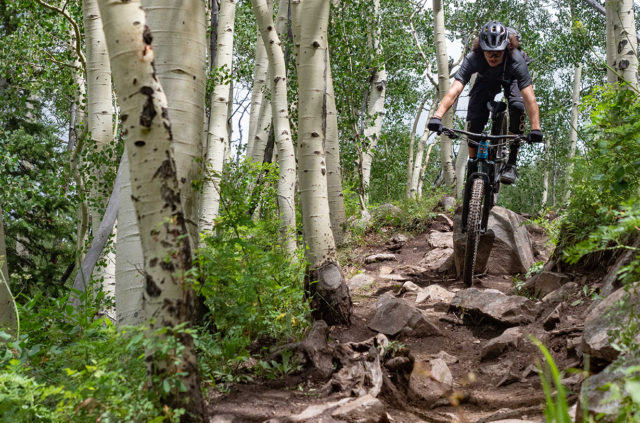
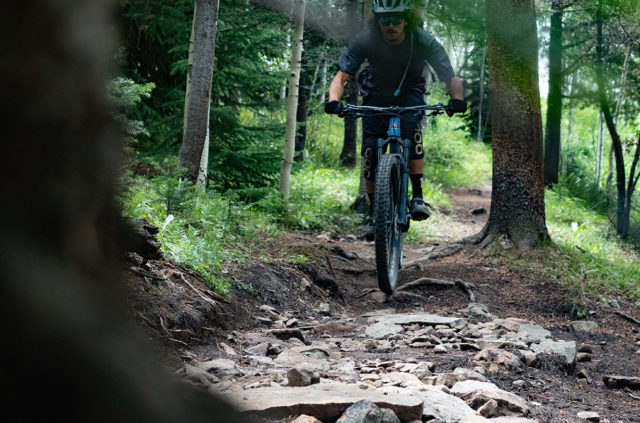
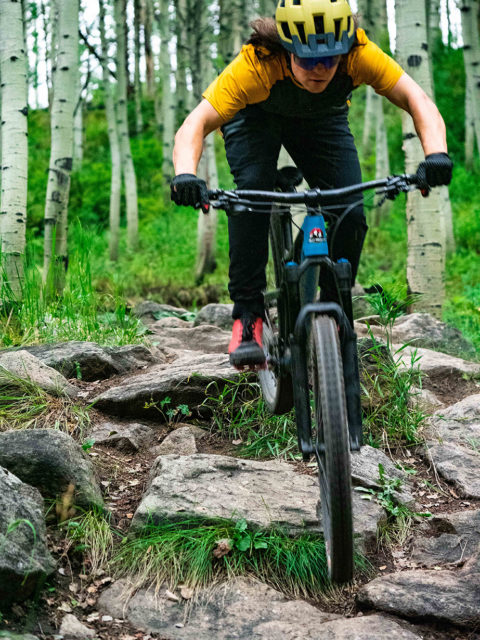
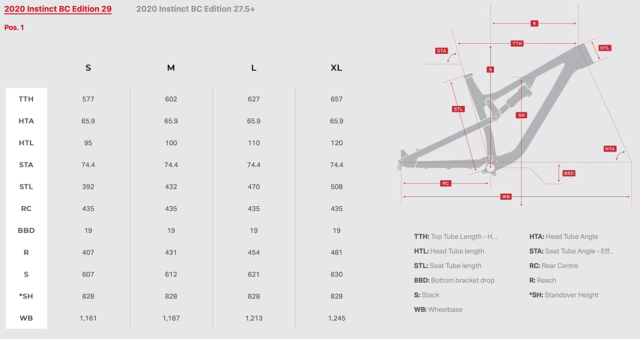
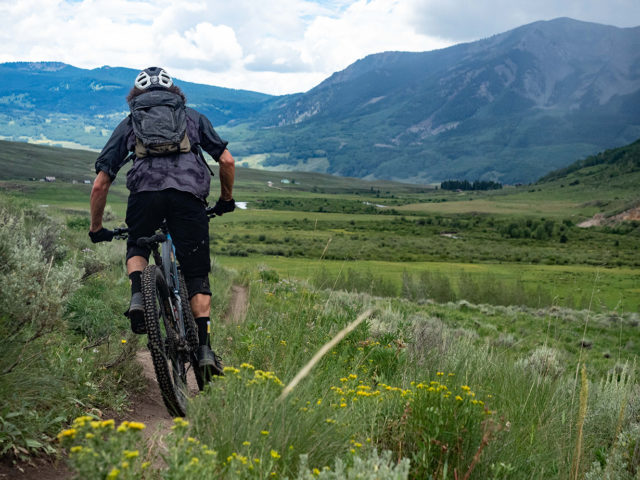
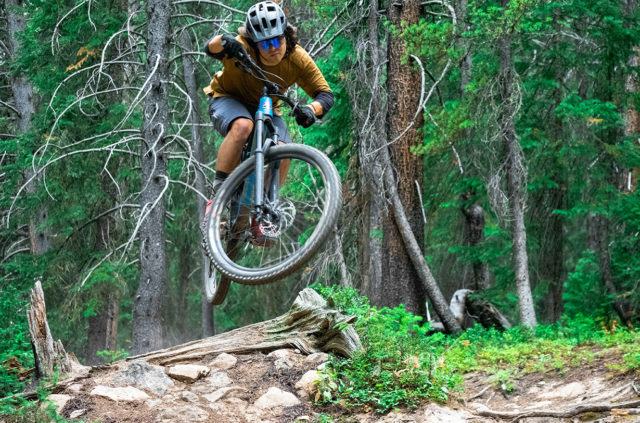
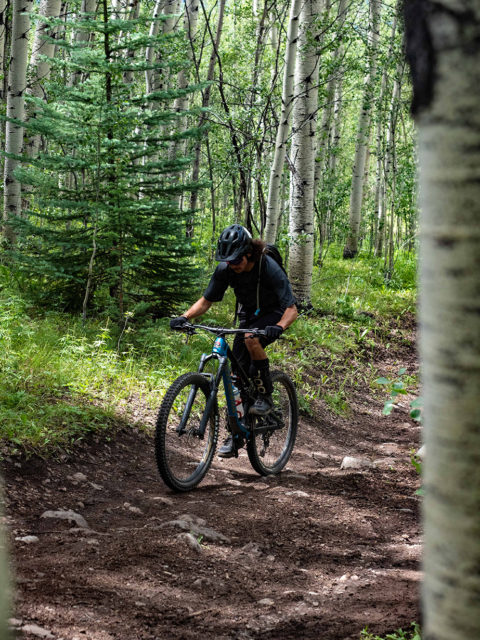
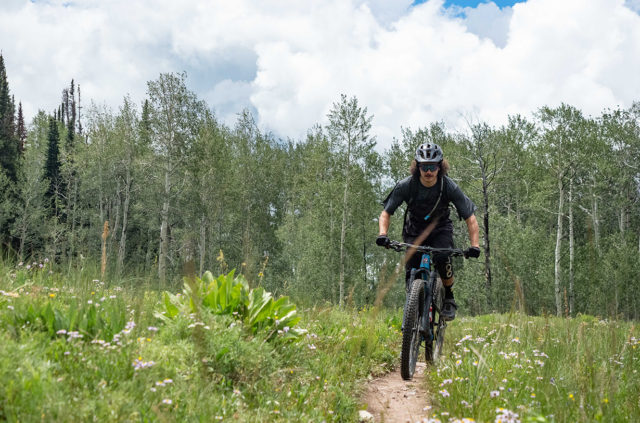
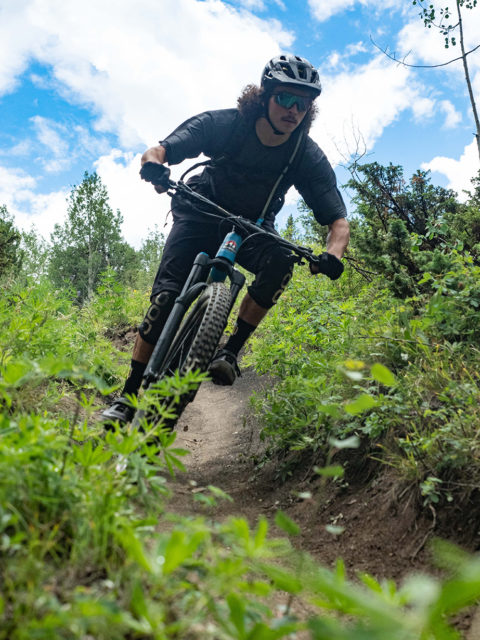
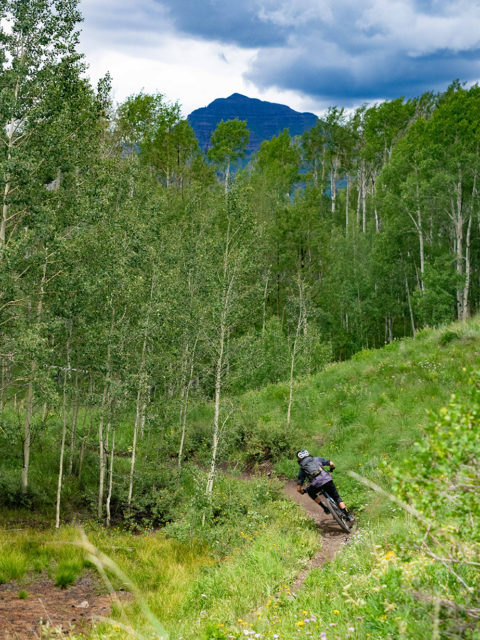
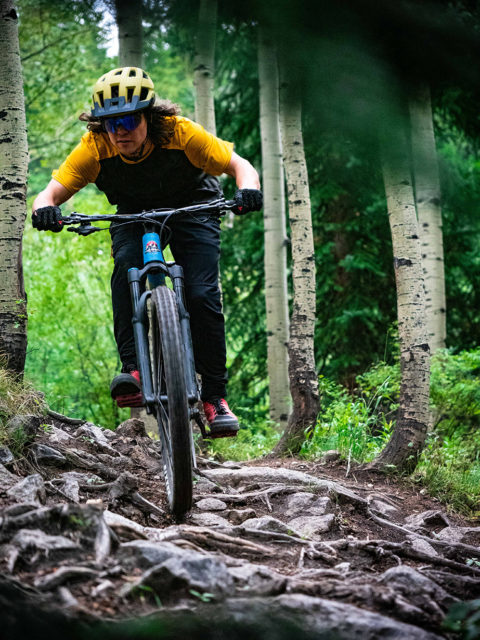
I skimmed the article so I’m sorry if I missed it, but it’s worth noting that the alloy version of this bike/frame was recently recalled. Thanks for the great content, guys.
Ah, thanks for the reminder — I just added a note about that.
I got the alloy version last year and have totally loved it. I previously was riding their similar travel 27.5 wheel size Altitude. I’ve demoed other brands, but really don’t have enough experience to make meaningful comparisons. But, I’ve ridden this bike on a lot of gnarly, rocky moto trails and climbed a ton on it and it does everything I want it to really well.
But the recall. I could use some advice on how pissed I should be. Rocky has, I think, a well-deserved reputation for great colorways on their bikes. Mine was no exception. But with the recall, they’re replacing every color with the most blah gray, I guess hoping for the least amount of clash. I get it that some people like that, and ultimately it’s not the end of the world. But when you pick a bike out of a very crowded field (as you point out in your review), and you spend a crap ton of money on it, it’s disappointing to see a mismatched gray with yellow or blue or whatever accents. I know from the interwebs that many other owners are also unhappy and disappointed. Basically, Rocky’s response is “Oh, sorry, eh.” which doesn’t seem likely to encourage any further brand loyalty.
@steve I wouldn’t be too worried about the grey color way. Unfortunately the rear chainstays are notorious for breaking In a manner which does not mandate a recall. So once those go you will have a matchy matchy bike again. This is ultimately the reason I did not purchase a my2020 instinct as both the internet and my local shop indicated I’d be waiting on stays at some point. Bummer is I loved how it rode when I demoed it.
Hey guys, I have a chance to buy a new, 2018 Carbon 70 in a hard-to-find-right-now size XL. What am I giving up witht 2018 vs the 2020?
Sorry we missed this! The frame would be the same, you’d just be getting some “older” components. I’m not sure how much that build has changed since 2018 (I can’t seem to find specs on the old builds) but the frame and geo would be the same as the version we reviewed.
I must have missed something, I thought all the EWS guys were rocking the Slayer.
It seems to vary a lot between the riders and different tracks, but most of them right now appear to be on a bike that is not the Slayer, but also not the current Instinct BC or Altitude. As far as we know, that mystery bike is what Jesse Malamed won yesterday’s Zermatt race on.
I’m coming from a 2018 150mm travel Scott Genius 920…the BC has taken my eye. Anyone know how they would compare? I loved the twinlock on the Scott for the climbing on half lock and the lockout for asphalt riding. Still want a mid travel trail bike that is playful but that manoeuvres better than the Genius.
Unfortunately, we haven’t had any reviewers on the Genius. I’m sure the Genius would feel more efficient on climbs when using the lockout, and their geo numbers are super similar, so at least from that perspective, I figure they’d feel pretty similar. The numbers are so similar that’s it’s really tough to say what the Instinct BC would improve over the Genius, without having ridden the Genius.
Excellent all round review BTW from a few different perspectives.
Great review, thanks.